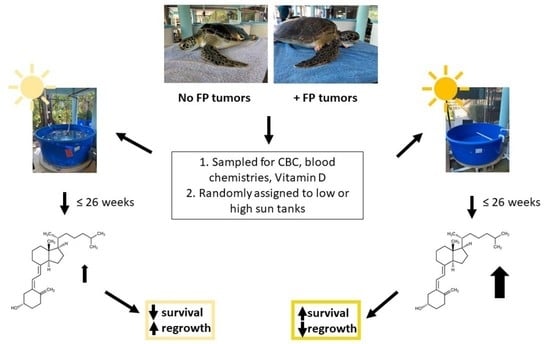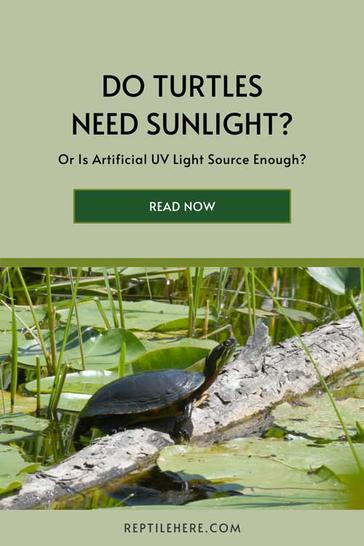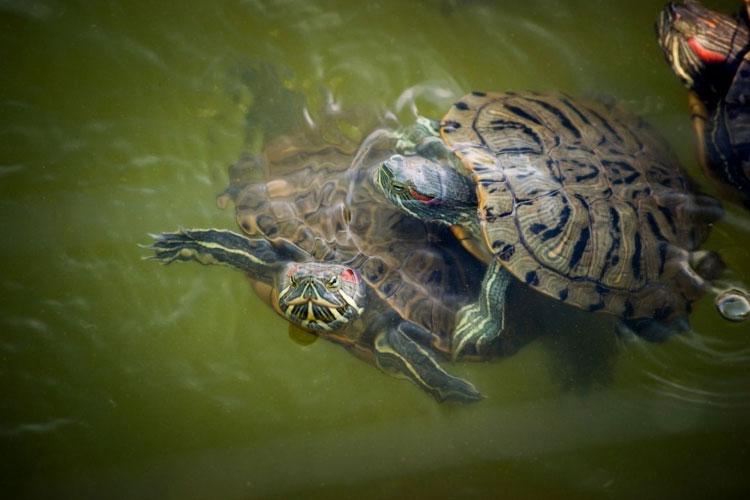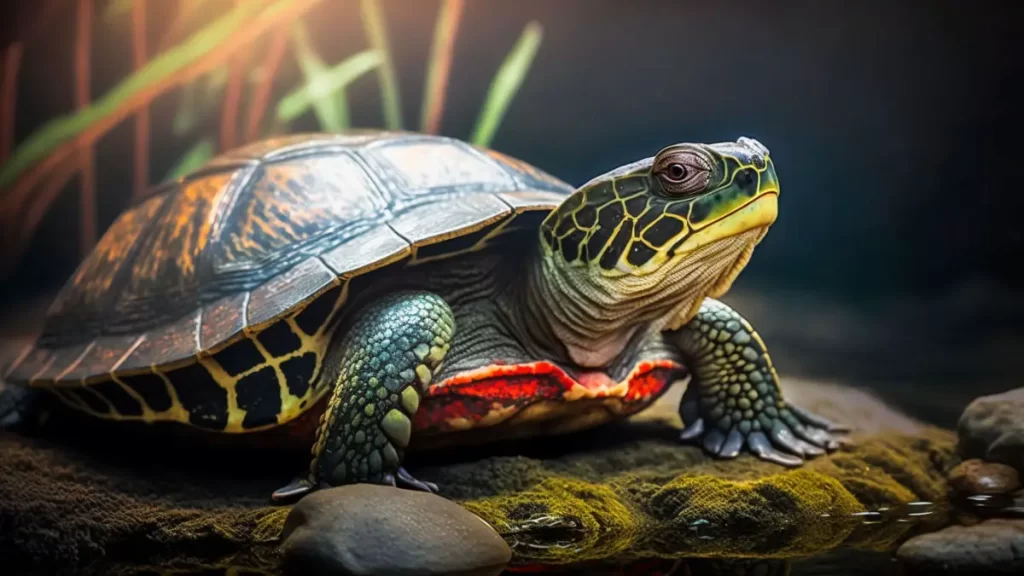Did you know that sunlight is not just beneficial for humans, but also for turtles? It’s true! Turtles rely on sunlight to perform a process called natural vitamin D synthesis, which is crucial for their overall health and well-being. In this article, we will explore the benefits of outdoor sunlight for turtles and how it helps them produce this essential vitamin.
When turtles are exposed to sunlight, their bodies are able to convert a compound present in their skin called 7-dehydrocholesterol into vitamin D3. This process is triggered by the sun’s UVB rays, which penetrate the turtle’s skin and activate the conversion. Once the 7-dehydrocholesterol is converted, it travels to the liver and kidneys to be further metabolized into its active form, vitamin D hormone. This hormone plays a vital role in calcium absorption, which is crucial for maintaining strong and healthy bones in turtles.
By spending time in the sun, turtles are able to regulate their calcium levels and prevent common health issues such as metabolic bone disease. This disease is characterized by soft and weak bones, which can lead to deformities, difficulty in movement, and even death in severe cases. Outdoor sunlight provides turtles with the necessary UVB rays to synthesize vitamin D and maintain optimal calcium levels, thus preventing such health problems.
In conclusion, outdoor sunlight is essential for turtles as it allows them to naturally produce vitamin D through a process called natural vitamin D synthesis. This vitamin is crucial for their overall health and plays a vital role in calcium absorption. By ensuring that your pet turtle gets enough exposure to the sun’s UVB rays, you can help them maintain strong and healthy bones, prevent metabolic bone disease, and promote their overall well-being. To learn more about the benefits of sunlight for turtles, keep reading our article!

Building Strong Bones: The Importance of Vitamin D
Understanding the Role of Vitamin D in Bone Health
Vitamin D is an essential nutrient for turtles, playing a crucial role in their bone health. It helps in the absorption of calcium, which is necessary for the development and maintenance of strong and healthy bones. Without an adequate amount of vitamin D, turtles may suffer from weakened bones, which can lead to deformities and other health issues.
The Dangers of Vitamin D Deficiency in Turtles
Vitamin D deficiency is a common problem among pet turtles, particularly those kept indoors or in habitats with limited sunlight exposure. Turtles that do not receive sufficient vitamin D are at risk of developing metabolic bone disease, a condition characterized by weak and soft bones. This can result in difficulties with mobility, shell deformities, and even life-threatening fractures.
The Benefits of Sunlight for Vitamin D Synthesis
Sunlight is the most natural and efficient way for turtles to obtain vitamin D. When turtles are exposed to sunlight, specifically UVB radiation, their skin produces a precursor molecule that is converted into active vitamin D in their bodies. This natural synthesis allows turtles to regulate vitamin D levels effectively and maintain optimal bone health.
The Process of Vitamin D Synthesis
The Science behind Vitamin D Synthesis in Turtles
Turtles possess a unique ability to produce vitamin D in their bodies through a process called endogenous synthesis. The key component in this process is the activation of a molecule known as 7-dehydrocholesterol, present in their skin cells. When exposed to UVB radiation from sunlight, the 7-dehydrocholesterol is converted into cholecalciferol, the precursor molecule of vitamin D.
How Sunlight Triggers Vitamin D Production
Sunlight, specifically UVB rays, penetrates the turtle’s skin and triggers the production of vitamin D. UVB radiation has just the right wavelength to interact with the 7-dehydrocholesterol in their skin cells, initiating the conversion process. The vitamin D produced is then transported to the liver and kidneys, where it undergoes further transformations to become the biologically active form of vitamin D.
Factors Affecting Vitamin D Synthesis in Turtles
Several factors can affect the synthesis of vitamin D in turtles. The intensity and duration of sunlight exposure, as well as the angle of the sun, can influence the amount of UVB radiation reaching the turtle’s skin. Additionally, the thickness and condition of the turtle’s shell, as well as any environmental obstructions such as vegetation or enclosure structures, can also impact UVB penetration and, subsequently, vitamin D synthesis.

Outdoor vs. Indoor Turtles: Sunlight Exposure Comparison
The Limitations of Indoor Lighting for Vitamin D Synthesis
While some turtle owners may rely on artificial UVB lighting in indoor enclosures, it is important to recognize its limitations. Artificial UVB bulbs may not provide the same spectrum and intensity of UVB radiation as natural sunlight. Moreover, the distance between the turtle and the light source, as well as the enclosure size, can affect the amount of UVB exposure the turtle receives. Therefore, relying solely on indoor lighting may not supply turtles with adequate vitamin D synthesis.
The Superiority of Outdoor Sunlight for Turtle Health
Outdoor sunlight is the ideal source of UVB radiation for turtles, as it provides the full spectrum of UVB wavelengths needed for proper vitamin D synthesis. Unlike artificial lighting, natural sunlight is abundant and readily available. When turtles are allowed access to outdoor enclosures, they can bask in the sun, absorbing the UVB rays they need to maintain optimal vitamin D levels.
Measuring Vitamin D Levels: Comparison between Outdoor and Indoor Turtles
Studies have shown that turtles kept in outdoor enclosures have significantly higher vitamin D levels compared to those kept indoors. Monitoring vitamin D levels through blood tests and comparing outdoor and indoor turtles consistently demonstrates the superiority of natural sunlight in promoting vitamin D synthesis. These findings emphasize the importance of providing opportunities for outdoor sunlight exposure for pet turtles.
Optimal Sunlight Exposure for Turtles
Determining the Ideal Duration and Intensity of Sunlight Exposure
The optimal duration and intensity of sunlight exposure for turtles depend on various factors, including the species, age, and health of the turtle, as well as the geographic location and the time of year. It is generally recommended that turtles receive around 30-60 minutes of direct sunlight each day, but it is essential to monitor their behavior and adjust the exposure accordingly to prevent overexposure or sunburn.
Creating a Safe Outdoor Environment for Turtles
When allowing turtles outdoor sunlight exposure, it is crucial to create a safe and secure environment for them. The outdoor enclosure should provide a balance of sun and shade, allowing turtles to regulate their body temperature and seek refuge from excessive heat. The enclosure should be escape-proof and protected from predators and environmental hazards to ensure the turtle’s safety.
Developing a Sunlight Schedule for Turtle Well-being
Establishing a consistent sunlight schedule for turtles is beneficial, as it mimics their natural behavior in the wild. Turtles are ectothermic, meaning they rely on external heat sources to regulate their body temperature. Providing regular access to sunlight allows them to bask and warm themselves, promoting healthy metabolism and overall well-being. Creating a daily or weekly sunlight schedule can help maintain stable vitamin D levels and ensure the turtle’s health.

Enhancing Shell Health through Sunlight
How Sunlight Affects Shell Growth and Strength
Sunlight plays a significant role in the development and maintenance of a turtle’s shell. Adequate sun exposure not only supports the synthesis of vitamin D but also stimulates the production of keratin, a protein essential for shell growth and strength. By basking in the sun, turtles can enhance the overall health, hardness, and resilience of their shells.
Preventing and Treating Shell Disorders with Sunlight
Sunlight exposure can also be beneficial for preventing and treating common shell disorders in turtles. Conditions such as shell rot and shell pyramiding are often associated with improper nutrition and insufficient UVB exposure. Allowing turtles to bask in sunlight helps dry and sanitize their shells, reducing the risk of bacterial or fungal infections. Additionally, the vitamin D synthesized through sunlight can support the healing and regeneration of damaged or weakened shells.
Promoting Shell Healing and Regeneration
Turtles with shell injuries or deformities can benefit greatly from sunlight exposure. The combination of UVB radiation and vitamin D helps in the absorption of calcium, supporting the healing process of shell fractures and promoting the regeneration of damaged tissue. By facilitating the growth of healthy bone tissue, sunlight can aid in the recovery and rehabilitation of turtles with shell injuries.
Improving Immune Function with Sunlight
The Impact of Vitamin D on Turtle Immune System
Vitamin D plays a crucial role in the proper functioning of the immune system in turtles. It helps regulate the production of antimicrobial peptides, which are substances that help fight off infections and diseases. Adequate levels of vitamin D can enhance the turtle’s immune response, making them more resilient to bacterial and viral infections.
Sunlight as a Defense against Infections and Diseases
By promoting vitamin D synthesis, sunlight exposure can strengthen the turtle’s immune system, acting as a natural defense against infections and diseases. Turtles with sufficient vitamin D levels are better equipped to fight off common illnesses, such as respiratory infections and shell rot. Providing regular access to sunlight can significantly reduce their susceptibility to these health issues.
Boosting Resistance to Shell Rot and Respiratory Infections
Shell rot and respiratory infections are common ailments among turtles, often caused by bacterial or fungal pathogens. Sunlight exposure can help prevent and alleviate these conditions by inhibiting the growth and spread of harmful microorganisms. The antimicrobial properties of vitamin D, coupled with the immune-boosting effects of sunlight, enhance the turtle’s resistance to shell rot and respiratory infections.

Mental Stimulation and Behavioral Benefits
The Psychological Effects of Sunlight on Turtles
Sunlight exposure not only benefits turtles physically but also has positive effects on their mental well-being. Turtles are diurnal animals, meaning they are active during the day. By providing them with access to natural sunlight, their natural behavior patterns and circadian rhythms are better aligned, promoting their overall mental stimulation and engagement.
The Role of Sunlight in Preventing Stress and Depression
Turtles kept indoors or in environments with limited sunlight exposure are prone to stress and depression. Lack of natural light can disrupt their internal clocks and lead to disorientation and behavioral changes. Regular exposure to sunlight helps minimize stress levels, maintain healthy hormonal balance, and prevent the onset of depression in pet turtles.
Promoting Natural Behaviors through Outdoor Sunlight Exposure
The enrichment value of outdoor sunlight for turtles is immense. Sunlight provides a range of sensory experiences, from warming their bodies to exploring their surroundings. Natural behaviors such as basking, exploring, and foraging are encouraged in outdoor environments, contributing to the turtle’s physical fitness, mental stimulation, and overall happiness.
Considerations for Providing Sunlight to Pet Turtles
Safe Outdoor Enclosure Design and Maintenance
When setting up an outdoor enclosure for turtles, safety should be a primary concern. The enclosure should have secure walls or fencing to prevent escapes and protect turtles from potential predators. Providing a solid and secure roof or mesh cover can help protect against aerial threats and ensure the turtles’ safety. Regular inspection and maintenance of the enclosure are essential to address any potential risks or hazards.
Supplementing Sunlight in Indoor Settings: UVB Lighting
In situations where outdoor access is limited or not feasible, supplementing sunlight exposure with UVB lighting is highly recommended. UVB bulbs specifically manufactured for reptiles can provide adequate UVB radiation to support vitamin D synthesis. It is crucial to select quality bulbs and regularly replace them according to the manufacturer’s instructions to ensure optimal UVB output.
Monitoring and Adjusting Sunlight Exposure for Optimal Health
Ongoing monitoring and observation are crucial in maintaining the turtle’s health and well-being. Regularly checking and recording the turtle’s behavior and overall condition can help determine if they are receiving sufficient sunlight exposure. Adjustments to the sunlight schedule or the use of supplementary UVB lighting may be necessary if the turtle shows signs of vitamin D deficiency or any other health issues.

Potential Risks and Precautions
Balancing Sunlight with Shade: Avoiding Overexposure
While sunlight is essential for turtles, it is crucial to strike a balance between exposure and providing shaded areas. Overexposure to the sun can lead to dehydration, heat stress, or even sunburn. Turtles should always have access to shady spots or retreat to cooler areas to regulate their body temperatures. Providing rocks, logs, or vegetation within the enclosure can create shaded areas for turtles to seek shelter.
Protection against Predators and Environmental Hazards
Outdoor enclosures should be designed to protect turtles from potential predators, such as birds, raccoons, or stray animals. Fences or wire mesh covers can deter predators from entering the enclosure and harming the turtles. Additionally, precautions should be taken to ensure the enclosure is free from toxic plants or chemicals that could pose health risks to the turtles.
Signs of Sunburn and Heat Stress: Identifying and Treating
Monitoring turtles for signs of sunburn or heat stress is crucial. Pale or discolored patches on the skin, blistering, or peeling are indications of sunburn. Heat stress symptoms include excessive panting, lethargy, loss of appetite, or acting unusually agitated. If these signs are observed, immediate action should be taken to provide shade, offer cool water for hydration, and consult a veterinarian if necessary.
Sunlight and Turtles in Conservation Efforts
Reintroducing Turtles to Natural Habitats: Importance of Sunlight
Sunlight exposure plays a vital role in conservation efforts involving endangered turtle species. For turtles bred in captivity for conservation purposes, ensuring their exposure to natural sunlight prior to release is crucial. Natural sunlight allows them to develop essential adaptations and behaviors necessary for survival in their native habitats, increasing their chances of successful reintegration into the wild.
Rehabilitation and Recovery through Sunlight Exposure
Injured or rescued turtles undergoing rehabilitation can greatly benefit from sunlight exposure. Sunlight not only aids in their physical recovery but also supports their emotional well-being. The combination of vitamin D synthesis, mental stimulation, and natural behavior expression can expedite the healing process and increase the chances of successful rehabilitation and eventual release.
Protecting Endangered Turtle Species with Sunlight Initiatives
Sunlight initiatives can play a pivotal role in the conservation of endangered turtle species. Providing outdoor enclosures or natural habitats with ample sunlight exposure allows these species to thrive and reproduce naturally. By replicating their natural environments and providing them with the necessary sunlight, we can contribute to the protection and restoration of their populations.
Educational Outreach and Awareness
Educating Turtle Owners about Outdoor Sunlight Benefits
Educating turtle owners about the benefits of outdoor sunlight exposure is crucial for their pets’ well-being. Many owners may not be aware of the significant role sunlight plays in a turtle’s overall health. Providing information on the natural vitamin D synthesis process, optimal sunlight exposure guidelines, and the potential risks of vitamin D deficiency can empower owners to make informed decisions and provide the best care for their turtles.
Promoting Responsible Turtle Keeping through Sunlight Advocacy
Advocacy for responsible turtle keeping should include a focus on sunlight exposure. Encouraging owners to provide outdoor enclosures or access to natural sunlight is an essential aspect of responsible pet ownership. Educating potential turtle owners about the importance of sunlight at the early stages can help prevent future health issues and promote the overall well-being of pet turtles.
Spreading Awareness about the Importance of Turtles and Sunlight
Raising awareness about turtles in general and the benefits of sunlight exposure is crucial for their conservation and protection. Highlighting the ecological significance of turtles and their vulnerability to habitat destruction, climate change, and human activities can garner support for conservation efforts. By emphasizing the positive impact of sunlight on turtles’ health and well-being, we can inspire a deeper appreciation for these remarkable creatures and the role sunlight plays in their lives.
Future Research and Innovations
Advancing Knowledge about Turtles’ Sunlight Requirements
Further research is needed to better understand the specific sunlight requirements of different turtle species. Investigating the optimal UVB levels and duration of exposure for various turtle species can provide valuable insights into their specific needs. This research can help refine sunlight exposure recommendations and contribute to the development of appropriate lighting and habitat design for pet turtles.
New Technologies for Simulating Natural Sunlight Indoors
Advancements in lighting technology offer promising opportunities for simulating natural sunlight indoors. Full-spectrum lighting and UVB emitting LED lights are continuously being developed and refined to provide a more natural and effective substitute for natural sunlight. These technologies can offer viable options for turtle owners who are unable to provide direct outdoor sunlight exposure.
Exploring the Effects of Different Sunlight Spectrums on Turtle Health
Research into the effects of different sunlight spectrums on turtle health is an area that requires further exploration. Different wavelengths of UVB radiation and the influence of UVA and visible light on vitamin D synthesis and other physiological processes in turtles are still not fully understood. Investigating the effects of specific sunlight spectrums on turtle health can provide valuable insights into the optimization of lighting and enclosure design for indoor turtles.
Conclusion
The Crucial Role of Outdoor Sunlight in Turtles’ Vitamin D Synthesis
Outdoor sunlight plays a crucial role in the vitamin D synthesis process for turtles. The natural UVB radiation activates the production of vitamin D, which is essential for their bone health and overall well-being. It ensures proper absorption of calcium, prevents bone diseases, and supports healthy growth and development.
Overall Benefits to Turtles’ Bone Health, Immune Function, and Behavior
Providing outdoor sunlight exposure offers a multitude of benefits to turtles. It improves their bone health, preventing conditions like metabolic bone disease, and enhances the strength and growth of their shells. Sunlight exposure also boosts their immune system, making them more resistant to infections and diseases. Additionally, it promotes natural behaviors, mental stimulation, and overall happiness in pet turtles.
Encouraging the Adoption of Sunlight Practices for Healthy and Happy Turtles
As responsible turtle owners, it is our duty to ensure that our pets receive adequate sunlight exposure. Whether through outdoor enclosures or supplementation with suitable UVB lighting, providing opportunities for natural vitamin D synthesis is vital for the well-being of turtles. By understanding the benefits of outdoor sunlight and advocating for its importance, we can promote the long-term health and happiness of our beloved shelled companions.